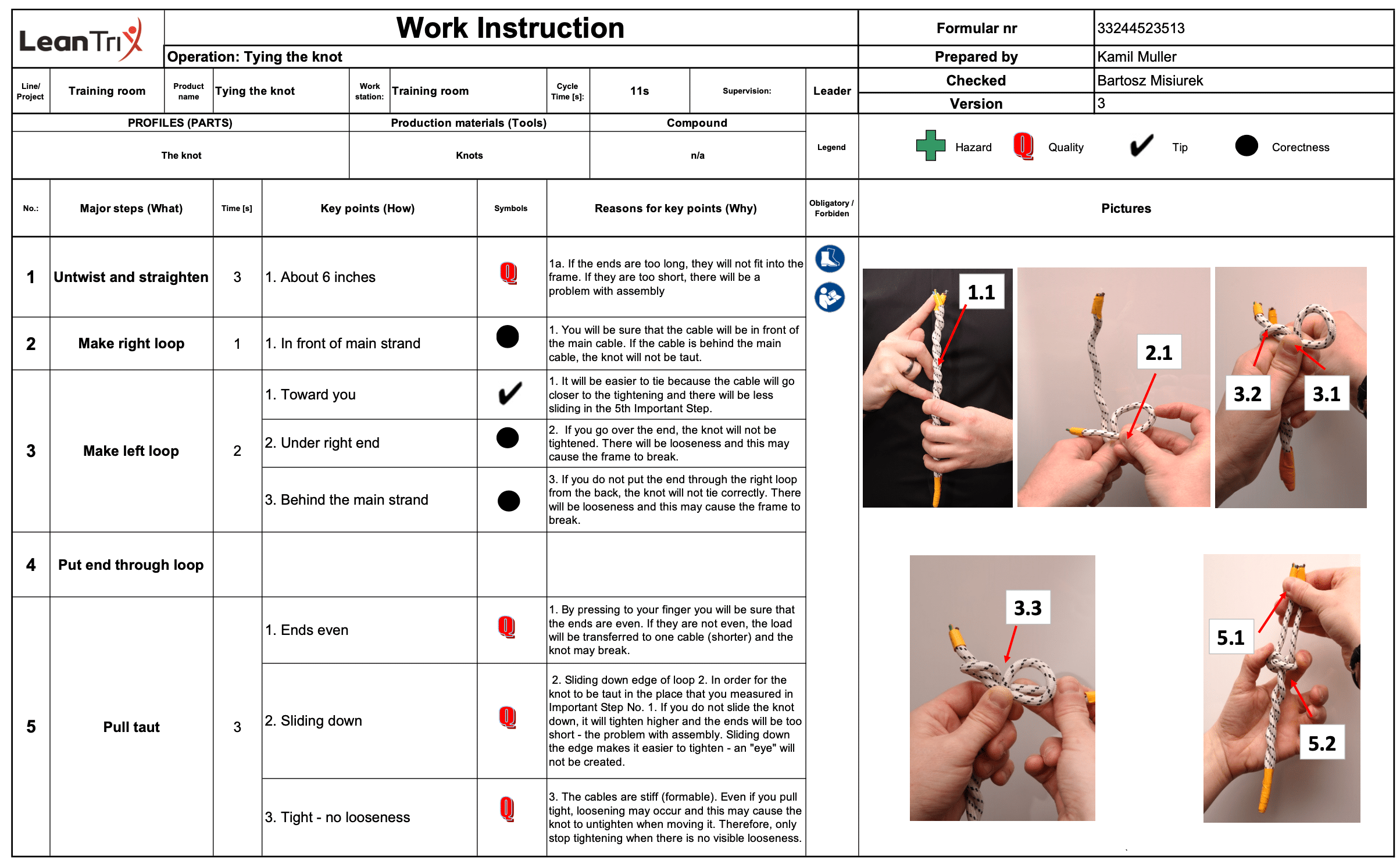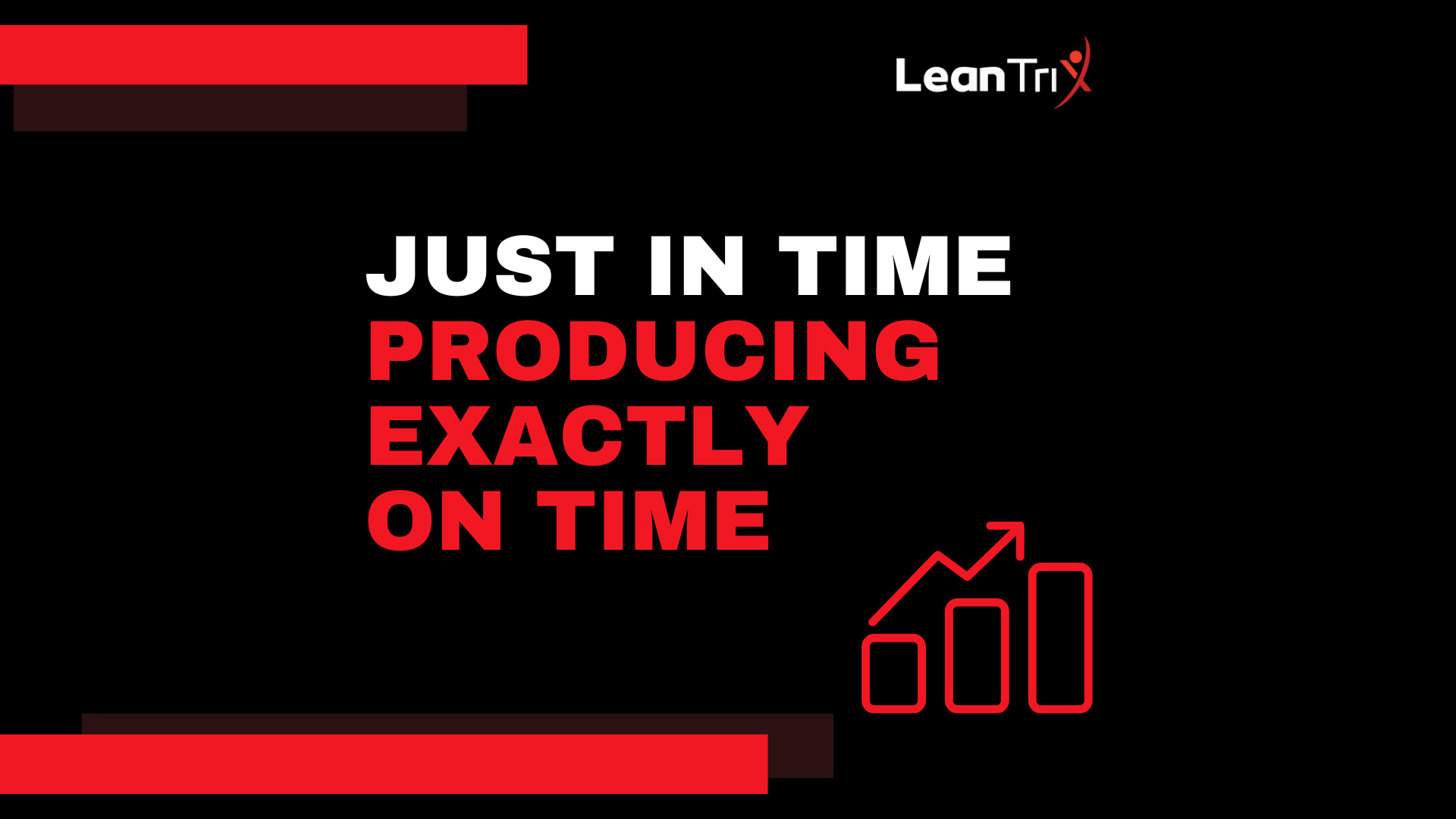TWI Key Performance Indicators – Job Instruction and the TWI program are currently experiencing a renaissance. The employee market means that effective and efficient employee implementation is crucial to keep them for longer. The TWI Job Instruction method is the most popular among the TWI program methods. It is a response to the problems of employee turnover that many enterprises are currently facing. Unfortunately, the attempt to implement the TWI JI method in most companies fails. From our experience of more than 250 production and service companies that have tried to implement the TWI JI method, it appears that 92% of them were unable to build a permanent system of managing on-the-job training. Of course, the vast majority of these companies have improved their existing systems, but not many have managed to fully implement this method as part of the system. What are the reasons? We will answer this question in the article. But let’s start with some basic information.
Work standardization according to Training Within Industry
The standardization of work is not about displaying standards at workplaces, but about providing employees with the best-known method of performing activities. This is the basic idea of the TWI program, where employee training which is based on previously prepared documents that divide work into important steps, key points and reasons for the key points, is key. Figure 1 shows the TWI Work Instructions, where this division has been applied. Table 1 presents the 4-step method of instructing employees, which guides an instructor following the PDCA (Plan-Do-Check-Act) cycle.
 Fig. 1. TWI Instruction – tying the underwriter’s knot
Fig. 1. TWI Instruction – tying the underwriter’s knot
Tab. 1. The TWI Job Instruction method
| Step | Steps for an instructor |
| 1. Prepare the learner |
|
| 2. Present the operation |
|
| 3. Try outperformance |
|
| 4. Follow up |
|
Purpose of the 4-step method
The purpose of the 4-step method is to standardize the instruction process that is carried out by a TWI Instructor (leader or experienced operator). TWI instruction standardizes the method of working on a given workstation. Implementation and maintenance of work standardization according to TWI enables many benefits to be achieved, including:
- the determination of one method of working on each shift, which is associated with a higher degree of stabilization and the predictability of a process,
- better production results due to the selection of the best-known method of work (experience: average improvement in productivity by over 10% after the implementation of TWI Job Instruction),
- a reduced share of production waste (experience: an average reduction of shortages by more than 35% after the implementation of TWI),
- more effective launching of new projects in a plant due to the standardization of operations at the stage of planning,
- the possibility of rotating employees between workstations (greater polyvalence),
- a smaller amount of committed mistakes as a result of improved employee awareness (emphasis on the reasons for key points).
Benefits of TWI for Key Performance Indicators
Most of these benefits are only noticeable after a long time and with the assumption that the implementation of the TWI Job Instruction method was effective. Many organizations have serious problems with the effective implementation and maintenance of the TWI Job Instruction. This is also the case with other Lean Management methods. However, the difference between the ineffective implementation of Lean methods and the TWI Job Instruction is significant. In the first case, after a failed implementation, the decrease occurs to a higher level of work organization than it was in the period before the implementation. This is due to the fact that its results remain visible, e.g. marking of storage areas after 5S activities at workstations or a reduction of the changeover time after SMED operations. In the case of the TWI Job Instruction method, it is a bit different. This is because the decrease takes place to the level in which the organization was before the implementation.
TWI simply dies. Instructors stop instructing according to the principles of this methodology, and standards become sheets of paper that after a short time cease to reflect the course of real production processes. Therefore, in the case of the TWI JI method, only effective implementation, and above all the maintenance of the system, can bring organizations to a higher level. However, a few companies succeed. Based on the experience of over 250 production and service plants, has been defined one basic problem regarding the implementation of the TWI JI method – a lack of established goals and measures. This seems to be a trivial problem, especially in organizations where there are a lot of performance indicators that measure various processes, e.g. companies where tools such as Hoshin Kanri are used. The challenge with the TWI Job Instruction is that it is at first glance a “soft” issue – related to the development of employees. This is why it is so difficult to set goals for this method. Usually, the intentions of companies when implementing the TWI Job Instruction are reduced to the assumption that is similar to the approach to other “soft” methods: let’s train our employees and they will then change their attitude. However, the TWI Job Instruction is also a way to standardize work, which can certainly be referred to a group of “hard” Lean methods.
It is thus a combination of improving the competences of employees and stabilizing production processes, and this causes problems with its indicators. Also, the TWI JI method is oriented to eliminate the root causes of problems in the area of quality, efficiency, or employee turnover, and therefore it is difficult to filter out data that shows the real impact of the methodology on the measured indicators. In this article, we present a set of key points that, depending on the vision for the TWI Job Instruction will help set and track goals. These key points were created based on our 12 years of experience in implementing TWI in over 250 enterprises on 4 continents.
Vision versus goals – TWI and Key Performance Indicators
Vision is the starting point for the implementation of the TWI JI method for improving Key Performance Indicators. It defines our view of the potential benefits of the methodology. The vision should be based on the organization’s needs that result from long-term goals. Table 2 presents examples of visions with goals and established KPIs.
Table 2. Vision, goals, and measures when implementing the TWI Job Instruction
| Vision for the implementation of the TWI JI method | Implementation goal | Example of TWI – Key Performance Indicators |
| Employees are polyvalent and can work on several operations | Frequent employee turnover between operations (employee polyvalence) | 70% of direct production employees who are trained on the basis of the TWI JI method on at least 3 production operations until the end of 2018 |
| New employees achieve full efficiency in the established and standardized time | A constant and standardized time of achieving the assumed effectiveness of work by a new employee | 16 production hours (after TWI training) in order to achieve 85% of work efficiency on a riveting operation |
| All production workstations have the best possible working method defined | Standardizing production operations using the TWI Instruction | 50% of production operations that are standardized based on TWI instructions by the end of 2018 |
| Mid-level managers are real leaders – can teach employees | A number of leaders and managers certified for TWI Instructors | 100% of leaders and managers who are certified to be TWI Instructors by the end of 2018 |
| New projects launched in an effective manner | All new projects covered by work standardization according to TWI | 100% of new projects have TWI instructions prepared 60 days before SOP (Start Of the Production)
At least two certified TWI Instructors per one shift 20 days before SOP (Start Of the Production) |
| Improvement of work productivity every year | Improvement of employees’ productivity (PPH – Parts per Hour) in the existing production area covered by TWI | Increase in productivity in the area by 8% after the implementation of TWI |
| Minimize of the amount of production scrap every year | Reduction of scrap in the existing production area covered by TWI | Reduction of scrap in the area by 20% after the implementation of TWI |
Employees are polyvalent
In companies where there is a problem with getting employees to work, as well as in companies with high absences, polyvalence is the key to the effective use of human resources. The objective of TWI should be an increase in the pollvalidity of employees in order for them to be able to work on several operations. The basic tool for tracking progress is the competence matrix, on which the training of staff can be easily visualized. Only those employees who have three quarters on the competence matrix next to a given operation (verified independent employee) or four quarters (TWI Instructor) are seen as independent employees. A measure that allows the process of increasing polyvalidity to be followed can be, e.g. 50% of direct production employees who have a minimum of 3 quarters on the competence matrix on at least 3 operations by the end of the year. Such a measure requires the development of a TWI Instruction and the training of TWI Instructors who are responsible for providing training. It is also worth introducing an audit that clearly defines the requirements for the transition from 2 quarters (non-independent employee working under supervision) to 3 quarters (an independent employee).
New employees achieve full efficiency
Organizations with complicated production processes often face the problem of long and ineffective implementation of new employees to work. The implementation of TWI, which is based on a vision related to the improvement of these elements, should generate the goal of standardizing the time of achieving a particular efficiency on a given operation by an employee. After a TWI training, the progress of an employee can be followed by marking it on a chart that has a clearly marked goal regarding efficiency and the time interval. It is best to monitor the performance indicator continuously, but if there is no IT support, it can be saved in the minute, hour, or shift approach, depending on the characteristics and difficulties of the process.
The goal is achieved when the effectiveness of the assessed employee does not fall below the set target. In order to determine this measure, work standardization and a method of training are required. It is not possible that there is one goal for all employees when each instructor trains according to a different method. It is worth disregarding one of the myths about the TWI JI method here: it shortens the time of on-the-job training. This is not true. On-the-job training is usually longer in the TWI Job Instruction than in standard training, which involves showing work and leaving a learner alone with instructions. However, the time of implementing an employee in order to achieve the assumed work efficiency is shorter in the TWI Job Instruction, because a TWI Instructor dedicates as much time to employees as they require. And it is the time of implementing an employee to work that should be measured, and not the time of his training.
All production workstations have the best possible working method defined
The percentage coverage of production workstations with TWI instructions is a good indicator of how widespread the Job Instruction method is in a plant. However, it is not only the percentage of coverage that matters but above all, the quality of the instructions. Therefore, this vision should be accompanied by an indicator that requires a review of the TWI instructions with regards to whether they are made according to the rules. The goal for this vision is undoubtedly the percentage coverage of the production area with TWI instructions, and the way to verify this indicator should be the implementation audit. Only after a positive result of the audit can it be concluded that the area is covered by the TWI JI method.
Mid-level managers are real leaders – they can implement TWI for better Key Performance Indicators
The development of the management skills of mid-level staff is a catalyst for the successful implementation of the TWI JI method. Well-trained and aware leaders contribute to the effective spread of the idea of the TWI program in an entire organization. The goal for this vision should be the percentage of certified TWI instructors among all managers and leaders. Certification for a TWI Instructor should be confirmed by an audit, which verifies a candidate’s skills in the area of informing on health and safety rules, quality, organization of work, as well as the method of dealing with the 4-step TWI JI method. Certification for a TWI Instructor should be preceded by a period of practicing under the supervision of a plant’s TWI Coach (expert). It is also worth starting the internal certification process in the company (diplomas, training materials, etc.).
New projects launched in an effective manner
The vision related to the implementation of the TWI JI method on new projects mainly concerns enterprises that actively search for new clients and launch new productions. Implementation of the TWI JI method on new projects is easier because we start from scratch. On the other hand, we cannot rely on the experience of our employees, because everyone learns work. The goals of implementing the TWI JI method on new projects should be comprehensively connected with the launch system of new productions. Such systems have defined “gates”, which should be closed until a specified time before the start of production (SOP). The TWI JI method should be incorporated into the production launch system. The order should be as follows:
- Listing of operations that are necessary for standardization (part of the competence matrix)
- Determining the needs regarding hiring employees (part of the competence matrix – positions, not specific people)
- Listing the important steps in operations (engineers and future leaders) during the prototyping phase
- Balancing work and implementing new workstations
- Development of the TWI Instruction on the basis of the defined important steps (leaders write key points and the reasons for key points)
- Recruitment of people and TWI training – filling the competence matrix that was developed in step 1
Improvement of work productivity and a reduction in production scrap every year
Productivity and quality are often the most interesting indicators for the management of an organization. They directly affect the company’s production results. The TWI Job Instruction eliminates the root causes of low productivity and poor quality, and therefore it is not easy to examine its impact on the achieved improvement. One of the methods may be the conducting of measurements for 20 days before implementation, and then excluding an area from measurements for the period of implementing the TWI JI method (e.g. 3 weekly activities). During this time, operators and leaders are involved in the creation of TWI instructions, and some of them become TWI Instructors. Instructors instruct all operators in the area with set standards regarding polyvalence. After the implementation period, there is a 20-day measurement period, which verifies the effectiveness of the implementation. This approach provides a clear definition of the benefits of implementing the TWI Job Instruction in a selected production area.
Summary – TWI and Key Performance Indicators
A problem with implementing the TWI Job Instruction is very often associated with a lack of specific implementation Key Performance Indicators, although the root cause of it is the difficulty in their determination and measurement. Unfortunately, without specifying goals, the implementation and maintenance of the system of TWI work standardization is likely to end in failure. The above-mentioned goals are successfully used in enterprises. The characteristics of the described goals enable them to be simultaneously used because they are not mutually exclusive, but on the contrary – they are complementary. All of this means that strictly defined goals and their clear communication to employees lead to the success of the TWI program in enterprises. The basis of the TWI program is people, and the standardization of work concerns the method of employees performing their duties – not only in the field of production but also regarding the transfer of knowledge and skills.
Learn more about TWI and Key Performance Indicators
Literature:

I am a promoter of Lean Management and the Training Within Industry program. I am a practitioner. I co-create many startups. Since 2015, I have been the CEO of Leantrix - a leading Lean consulting company in Poland, which, starting from 2024, organizes one of the largest conferences dedicated to lean management in Poland - the Lean TWI Summit. Since 2019, I have been the CEO of Do Lean IT OU, a company registered in Estonia that creates the software etwi.io, used by dozens of manufacturing and service companies in Europe and the USA.






